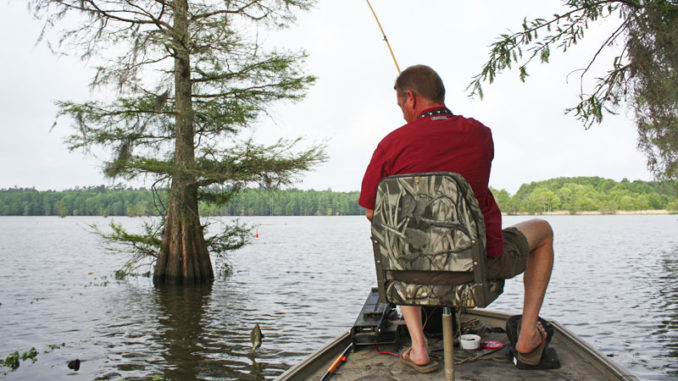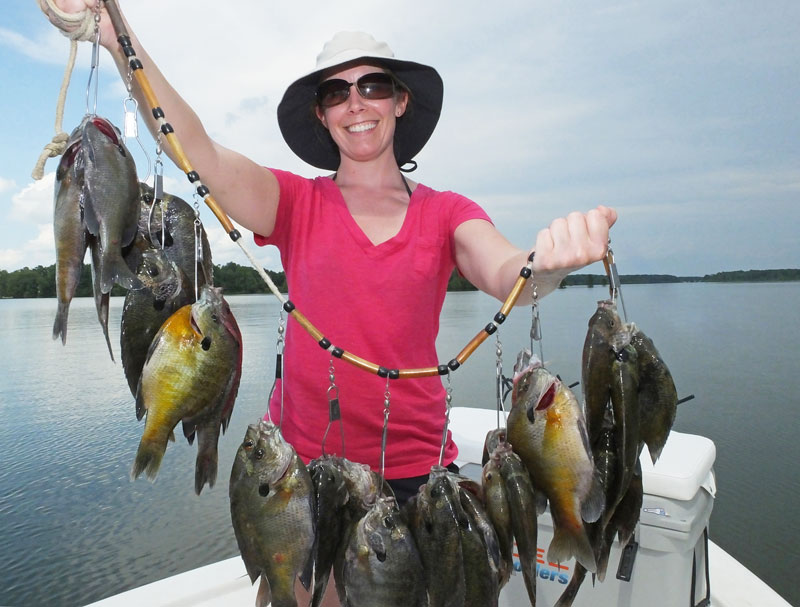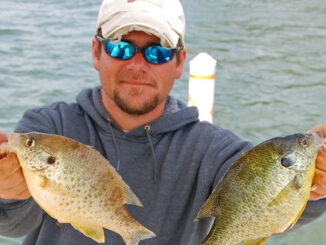
Plenty of tasty panfish head in to bed
May is an outstanding month for fishing on the Santee Cooper lakes, but the bream fishing is off the charts in popularity and productivity. The influx of anglers wanting in on this fast-paced action is known to lead to traffic jams at boat landings, especially on fair-weather weekends in early May.
Bream bustin’ rig
Bream, specifically bluegill and other sunfish species, will bed during May and will continue to bed over the next two or three months. Shellcrackers, aka redear sunfish, typically bed in April, but plenty of these panfish will bed again during May. Anglers commonly catch limits, with bluegills and shellcrackers contributing to the catch.
Plus, when they’re not on the beds, the techniques for taking bream are still very similar to bed-fishing in terms of locating fish.
Most local experts use the “hunt and peck” method for finding Santee Cooper bream beds. The process is to search shallow water while slowly moving until a hot spot is found.
A highly popular rig for fishing the heavy cover is a 9- to 12-foot pole referred to as a Bream Buster. Most anglers use 8-pound line with a small bobber rigged so depths can be changed quickly. When tying line to the eye of the pole, a good tip is to use a drop or two of super glue to ensure the tip isn’t literally snatched off the pole by a hard fighting bream. The line should be as long as the pole and tied to a No. 6 wire hook about 8 inches below a small split-shot.
The bait of choice for most “breamaholics” is a live cricket, but red worms work great and improve the odds of hooking more shellcrackers. Drop a cricket near a bream in May, and you’d best be prepared to battle a bull bream.
Using a swinging motion to control the presentation enables an angler to nestle the bait next to trees, weeds, logs and brush. It’s ideal fishing around and under the unforgiving snags such as low, overhanging cypress limbs.
Simple spinning or spincast (push-button) rigs work well for most fishing situations if you prefer.
Locating, catching Santee Cooper bream
Not all bream habitat is created equal, so focus on areas with a firm substrate; bream prefer sand and gravel over mucky bottoms. They also love to orient to cover, especially when not bedding.
Probe different depths as you search until you determine a pattern. With a slip or pegged float, you can change the depth of the bait quickly and accurately. Typically, 2 to 4 feet is prime depth, but it can vary deeper or shallower based on the habitat being fished.
If the fish caught are small or “hen” bream, release them and keep moving. If you catch a couple of big bream in the same area, work it thoroughly. One or two big bream on the outer edges can betray the location of an entire bed.
If you’ve found a bed, you may catch a limit right in that area — or as least get a strong start. If fish are not bedding, you may catch a handful of keepers or maybe more from that spot.
When the action slows, don’t linger; resume the search and be sure to keep a good count on the bream caught. It’s surprising how quickly you can reach a limit, or multiple limits, with steady action.
Santee Cooper hot spots
When everything looks like great bream habitat, it’s hard to narrow it down. First, look for other boats. If a lot of boats are tight against the trees and weeds, you’re in a good area. Be respectful; don’t try to get too close to others. Odds are high plenty of beds are available, so go find one you can fish with some amount of privacy.
Productive areas include the upper end of Lake Marion, especially the Pack’s Flats area, along with the target-rich environment around Low Falls and down to Jacks Creek. The lower end of Lake Marion has Eutaw, Mill, Taw Caw, Potato and Wyboo creeks, all loaded with bream. The flats around Rocks Pond produce bumper catches.
Lake Moultrie has amazing bream fishing in the shallow ring of water around the lake, with the area around Blacks Camp legendary as a bream-bed haven. The Hatchery is renowned for monster bream, and the Bonneau Beach area has coves and pockets of all shapes and sizes that hold bream.
Other months can offer excellent shallow water bream fishing but May is THE month for finding more bull bream in shallower water than at any other time of the year.
Lifting a limit
South Carolina groups seven different sunfish under the designation “bream” — bluegill, flier, warmouth, pumpkinseed, green sunfish, redear (shellcracker) and spotted sunfish. The daily limit is 30 fish per angler. The only popular sunfish not included is redbreast, managed by a 15-fish limit.





